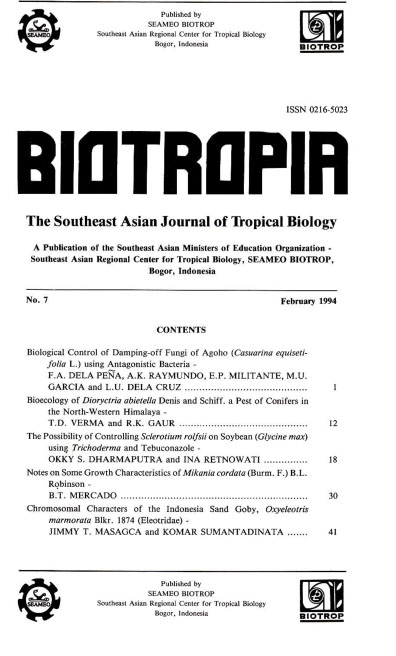
Tags
THE POSSIBILITY OF CONTROLLING SCLEROTIUM ROLFSII ON SOYBEAN (GLYCINE MAX) USING TRICHODERMA AND TEBUCONAZOLE*)
Content Language : English

The possibility of controlling S. rolfsii on soybean (Glycine max) var. Rinjani using T. aureoviride and
Tebuconazole under field conditions was studied. The experiment was conducted at the experimental plot of
SEAMEO BIOTROP.
The pathogen was mixed with the soil (2 kg/plot) 4 days before the inoculation of the antagonist (2.25
kg/plot). The measurement of each plot was 2.5 x 6 m2
. N, P and K (120 kg/ha) were applied at the same day
with the inoculation of the pathogen.
Soybean seeds were planted 7 days after the inoculation of the antagonist. The distance between plants and
between plots were 20 and 40 cm, respectively.
The fungicide at concentration of 100 g/ha (in vitro concentration) and 210 g/ha (field or
recommended concentration) were applied using 2 methods, i.e. 1) spraying on the planting hole at the same day
as the planting of soybean seeds, and 2) spraying on the soil surrounding the plants 7 days after planting. Soils
that were neither inoculated with the antagonist nor the fungicide were used as controls. Three replications (3 plots)
were used for each treatment (including the control).
The results showed that the inoculation of the antagonist, the concentrations of the fungicide, and time
of application gave very significant differences in the percentages of the plants infected by the pathogen and
significant differences in seed production; while the interaction between the inoculation of the antagonist and the
concentrations of the fungicide, between the concentrations of the fungicide and the time of application, and
between the inoculation of the antagonist, the concentrations of the fungicide and the time of application did
not give significant differences either in the percentages of the plants infected by the pathogen or seed
production.
The percentage of plants infected by the pathogen was lower on soil inoculated with the antagonist (31.6%)
than on soil not inoculated with the antagonist (52.9%).
The percentage of plants infected by the pathogen was lower on soil treated with the fungicide either at in
vitro concentration (37.5%) or at field concentration (37.4%) than on the soil not treated
Link

This work is licensed under a Creative Commons Attribution-NonCommercial-NoDerivatives 4.0 International License.
